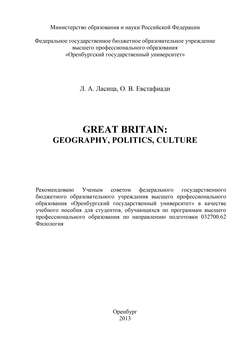Читать книгу Great Britain: geography, politics, culture - Л. А. Ласица - Страница 15
На сайте Литреса книга снята с продажи.
2 History of Britain: from Early Britain to the Middle Ages
2.8 Exercises
ОглавлениеExercise 1 Can you answer these questions?
1) Who were the first to inhabit the British Isles?
2) Which part of the British Isles was named Britain and why?
3) When did the army of Julius Caesar first invade Britain?
4) What was the function of ‘Hadrian's Wall’ during the Roman conquest?
5) What kingdoms were formed by the Germanic tribes?
6) When did the Norman invasion to Britain begin?
7) When did the first Parliament appear?
Exercise 2 Test yourself: choose the most suitable answer.
1 What ancient tribes inhabited the British Isles B.C.?
a) the Celts;
b) the Saxons;
c) the Angles;
d) the Vikings.
2 Which part of the British Isles was named Britain?
a) Southern;
b) Northern;
c) Western;
d) Eastern.
3 Together with a high civilization the Romans brought… to the country.
a) Slavery;
b) Culture;
c) Destruction;
d) Christianity.
4 The Saxons formed several kingdoms in the… part of Britain?
a) north-eastern;
b) south-eastern;
c) south-western;
d) western.
5 What led the Anglo-Saxons kingdoms to unification?
a) idea about wealth;
b) task of defending the country;
c) cold weather;
d) good relations.
6 When did the Norman invasion to England begin?
a) 1066;
b) 829;
c) 1576;
d) 1606.
7 Who became the king of England after the Norman invasion?
a) William the Conqueror;
b) King Egbert;
c) Henry IV;
d) Henry VIII.
8 The Normans spoke …and it was the language of the upper classes.
a) English;
b) German;
c) French;
d) Russian.
9 What is the most mysterious monument of the British past?
a) Ben Nevis;
b) Stonehenge;
c) Hadrian Wall;
d) Big Ben.
10 What was Robin Hood famous for?
a) He was a very handsome man.
b) He was the Norman’s leader.
c) He helped poor people.
d) He was one of the British kings.
Exercise 3 Complete the gaps in the text with the appropriate forms of the verbs given on the right.
Roman Roads
Within four years of invading Britain in AD 47, the Romans had built over 1,000 miles of roads!
Exercise 4 Read the text and answer the questions:
1. List the reasons why the Roman Army built roads.
2. Which of these reasons do you think is the most important?
3. Explain in your own words what a Groma was and how it was used to build straight roads.
4. Why were Roman roads quick and safe to travel on?
5. Why was the surface of a Roman road curved?
So how did the Romans manage to build such straight roads?
Roman engineers used an instrument called a Groma. This was a pair of boards fastened together into a cross shape. Lines with weights were hung from each corner so that they could get a straight line by lining up the weights with a pole a hundred meters or so away. In forest areas they built fires in a straight line and used the smoke as markers for the Groma.
Once the road had been planned the Roman soldiers dug two ditches on either side of the road to act as drains. The earth from these ditches was piled into the centre and rammed down. Stones were then gathered from the local area and laid down in different layers until they formed a hard surface that could take the weight of heavy carts. The surface of a Roman road was shaped into a camber so that rain water would run off into the ditches.
Roman roads were very quick and safe to travel large distances. The Roman soldiers were not the only people to use them. Merchants used them to carry goods all over the Roman Empire. The Romans built Britain's first proper roads. After the Romans left they were allowed to decay because people forgot how to rebuild and repair them. People continued to use the roads the Roman Army had built until 1745. Many modern roads are built along the original routes planned out by the Romans.
Did you know?
– Silburry Hill, in the English county of Wiltshire, is the largest man-made earthen mound in Europe. It was built about 4750 years ago.
– The stone circle at Avebury is the largest in the world. It was built between 5300 and 4600 years ago and covers 11 ha (28 acres). The outer circle is surrounded by a bank and ditch long of 1,5 km (1 mile).
– The so-called British Imperial system of measurement (English units in the USA) has its roots in Roman units. The Romans also counted in feet, which they divided in 12 inches (unciae in Latin, from which the English word is derived). 5 feet made a pace, and 1000 paces (mille passus) became a mile in English. The Roman gallon was the congius (worth 0,92 U.S. gallons). The word pint comes from Latin picta ("painted"), via the Old French pinte, and corresponded to a painted mark on a vessel indicating this measure. Other units like the pound only evolved in the Middle Ages.
– Colchester in Essex is the oldest recorded town in Britain, as well as the first Roman town and Roman capital of Britain. Colchester Castle has the largest keep ever built in Europe, having a land area 50 % bigger than the Tower of London.
– The Fossdyke, connecting the River Trent at Torksey to Lincoln, is the oldest canal in Britain. It was built by the Romans around 12 °CE and is still navigable today.
